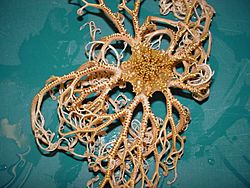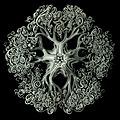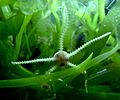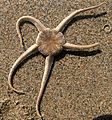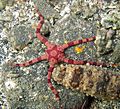Brittle star facts for kids
Quick facts for kids Brittle-star |
|
|---|---|
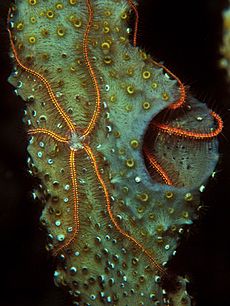 |
|
| Ophiothrix suensonii s brittle-star only found on sponges | |
| Scientific classification | |
| Kingdom: | |
| Phylum: | |
| Class: |
Ophiuroidea
Gray, 1840
|
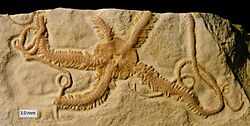
Brittle stars are amazing sea animals. They belong to a group called Echinoderms. This group also includes starfish and sea urchins. Brittle stars look a lot like starfish, but they are actually different. They have a hard outer skeleton made of calcium plates. They also have a body shape that is like a circle with arms coming out, which is called radial symmetry. There are about 1,500 different kinds, or species, of brittle stars.
Most brittle stars have five arms. These arms can grow very long, up to 60 centimeters (about 2 feet) in the biggest species. Their central body disk can be from three to eight inches wide. Unlike starfish, brittle stars often live in deeper parts of the ocean. Some can even be found in the deepest parts, more than 6,000 meters down! But you can also find them in reefs, hiding under rocks or inside other living things. Most brittle stars live below 500 meters deep.
There are two main types of Ophiuroids: the brittle stars (Ophiurida) and the basket stars (Eurialida). Basket stars usually live in deeper waters. Brittle stars mostly eat dead plants and animals, like scavengers. They can also catch small prey sometimes.
Contents
What Brittle Stars Look Like
Many brittle stars are quite delicate. This is how they got their name. If you pick one up, its arms might break off easily. This might seem strange, but it's actually a clever way for them to escape from predators. It's like a lizard dropping its tail!
How Brittle Stars Move
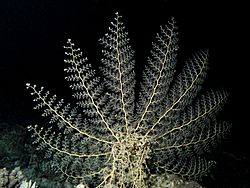
Brittle stars move differently from starfish. They don't use their tube feet to walk. Instead, they use strong muscles in their long, thin arms. They can move quickly over rocks when they are disturbed. Brittle stars are much faster than starfish. Their arms have special plates that fit together. These plates only let the arms move from side to side. This is why they move so fast.
Basket stars, on the other hand, can move their arms up and down. This difference in movement helps scientists tell the two groups apart.
Most brittle stars are scavengers or detritivores. This means they eat small bits of food that float in the water or are found on the seafloor. They use their tube feet to move these tiny food particles into their mouth. Sometimes, brittle stars also hunt small crabs or worms. If there are many small floating organisms, brittle stars will eat those too. In places where many brittle stars live close together, they often eat food that drifts by in the ocean currents.
Basket Stars
Basket stars are a type of brittle star. They are usually much larger and have many arms that branch out. These arms can move in any direction, which is different from other brittle stars. Basket stars can catch food by filtering it from the water. They use a sticky coating on their arms to trap tiny plankton and bacteria. They often stretch out one arm to catch food, while using their other four arms to hold onto something. Their arms have so many branches that they look like feathers. They are called "basket stars" because when they spread their arms out to feed, they look like the bottom of a basket.
Basket stars can be very big and heavy. The largest one, called Gorgonocephalus stimpsoni, can weigh up to 5 kilograms (11 pounds). Its arms can be 70 centimeters (about 2.3 feet) long, and its body disk can be 14 centimeters (about 5.5 inches) wide.
Gallery
-
A brittle star on a sponge
Images for kids
-
Brittle star in Kona, Hawaii
-
Asteriacites, a trace fossil of an ophiuroid; Carmel Formation (Middle Jurassic), near Gunlock, Utah; scale bar is 10 mm.
-
A field of the soft coral Callogorgia sp. with its brittle star symbionts
-
An Ophiothrix fragilis brittle star with missing arm segments from Póvoa de Varzim, Portugal
-
Micro brittle starfish and Caulerpa racemosa
-
Plate of brittle stars from the Kunstformen der Natur from Ernst Haeckel (1904)
-
Tropical black brittlestar (Ophiocoma erinaceus) held in hand at Reunion island.
See also
 In Spanish: Ofiuroideos para niños
In Spanish: Ofiuroideos para niños


